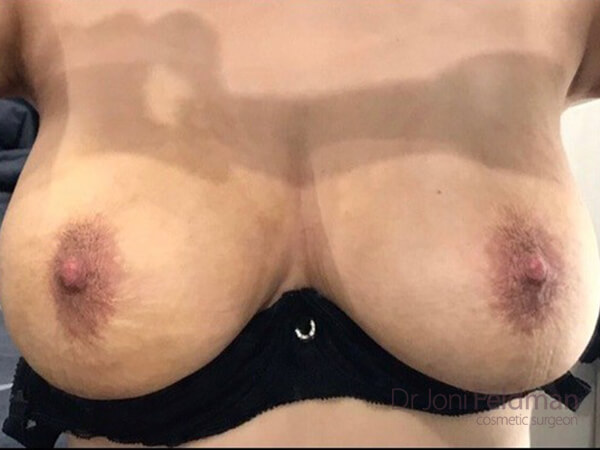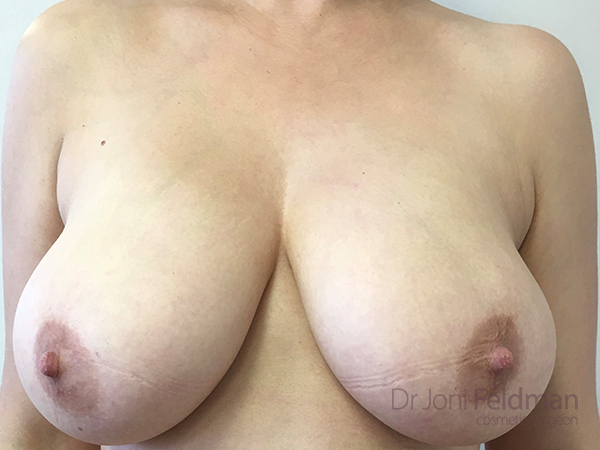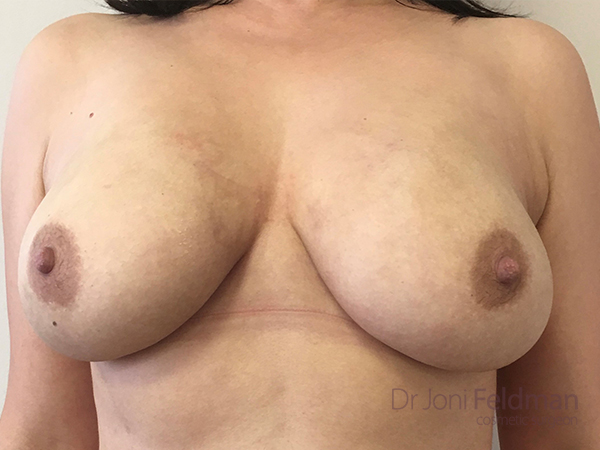
When reducing the size of one or both breasts (bilateral breast reduction), there are two main options. There is conventional open surgery – which involves various incisions, scarring, surgery time, a lengthy recovery and a general anaesthetic. And, there is liposuction, which requires 2 mm incisions, takes typically 2 to 3 hours, and ca be done under local anaesthesia.
Patients can expect to lose one to two bra cup sizes or 30 to 50% of the volume of the breasts through breast reduction by liposuction under local anaesthetic.
After liposuction of the breast, the skin retracts and at 4-6 months the maximum amount of contraction can be seen. This results in elevation of the breast. Often there can be a 5cm elevation noted from the nipple to the notch on the sternum (breast Bone ). For women who want smaller breasts and like their own shape, liposuction is be recommended.
The degree of elevation depends on the size and amount of fat removed. Additionally, there is individual variation with each patient.
Before proceeding, you will need to discuss your needs, wants and expectations with at least two appropriately trained doctors to determine what is best for you. However, women should know that open surgery is not the only option. The time, money and effort involved in open surgery should be considered seriously – especially when breast liposuction can offer results – without changing the position of the nipple, and sparring of the breast duct system.
Before and After Breast Liposuction Photos

BEFORE: Areolas margins are larger in before pictures ; weight from fat tissue stretches breasts and nipples downwards.

AFTER: Areolas contract, appearing smaller; breasts lift, with nipples sitting higher and closer to armpit.

BEFORE: Areolas appear larger; nipples sit low from armpit.

AFTER: Areolas appear smaller; nipples sit closer to armpit.
The ‘before and after’ photographs on Dr Joni Feldman’s website illustrate examples of tumescent liposuction under local anaesthesia. Results may vary, depending on the individual. Any surgical or invasive procedure carries risks. Read more about surgical risks here. Before proceeding, you should seek a second opinion from an appropriately qualified health practitioner.
Why have a breast reduction/lift?
If you have heavy breasts, you are likely aware of the difficulties they can cause.
- Difficulty finding suitable, well-fitted clothing
- Cervical (neck), thoracic and lumbar vertebral strain
- Postural problems
- Difficulty exercising
- Fatigue – due to carrying excess weight
- Difficulty sleeping due to the discomfort of heavy breasts
- Being uncomfortable with unwarranted attention or comments regarding your breasts in public
- Skin rashes, chafing and infections in the skin under the breasts
Finally, some women opt for breast reduction surgery due to asymmetry – when one breast is noticeably larger than the other.
Read more about the benefits of breast liposuction here>
Potential liposuction risks
It is essential you understand all the risks involved with liposuction to make an informed decision before proceeding.
Complications associated with liposuction may include asymmetry, skin rippling, excessive loose skin, poor scarring, abnormal skin pigmentation, bleeding, infection, seroma formation (fluid accumulation under the skin), deep vein thrombosis, cardiac and pulmonary complications, swelling, poor wound healing, bruising, and a potential need for revision surgery. Dr Feldman will discuss all potential surgical risks with you at your initial consultation. She will be happy to address any concerns or questions so that you are fully informed before proceeding with your surgery.
Australian Studies Highlight Long-Term Benefits of Breast Reduction
Breast reduction liposuction offers far from just cosmetic correction. Read our article on the 12-year cohort study highlighting the chronic health problems of women with large breasts, –
Am I a candidate for breast reduction liposuction?
As with any surgical procedure, not everyone is a candidate. There are a few restrictions that may prohibit you from proceeding. However, below are indications of where liposuction breast reduction can be an appropriate option:
⇒ Large amounts of fatty tissue
If your breasts have a lot of fat tissue, liposuction can be an excellent option as fat is the primary substance removed during the procedure. Conversely, if your breasts are densely filled with glandular tissue, then liposuction may not be recommended. Dr Feldman will send you for a mammogram with tomosynthesis (a form of 3-D mammography).
This screening procedure is similar to a mammogram, but it produces a 3-D image (rather than flat) to determine your breast density.The mammogram also shows the exact volume in each breast so that the desired amount of fat can be removed to give a symmetrical breast shape. This is especially useful when your breast has uneven volume.
⇒ General anaesthesia is not possible/desired
Some patients cannot have general anaesthesia for health reasons; others simply prefer to avoid a GA whenever possible. Breast (lift) liposuction does not require a general anaesthetic. The patient will be awake throughout their procedure, and only local anaesthetic and a sedative be used.
⇒ Free from excessive stretch marks
If your breasts are not deeply scarred with excessive stretch marks, then liposuction may be a good option. If you have skin that has scarring, conventional surgery may be the preferred choice.
⇒ Breast sag due to excess weight
Although some doctors argue that some breast can only be lifted through surgery, Dr Feldman sometimes disagrees. She repeatedly sees clients with breasts that sag due to the excess fat tissue that, once removed, the breast tightens and lifts considerably higher.
Candidates who should avoid breast liposuction
Not everyone is a candidate for breast liposuction. If you have a large amount of glandular tissue and not fat tissue, have extremely large breasts which have dropped or stretched, have become considerably misshapen or have breast skin with excessive scar tissue, then conventional surgery may be the best option.
Breast cancer is also an important factor. If you have an existing breast lump, this must be carefully assessed to ensure it is not cancer. Again, Dr Feldman sends all patients for a mammogram with tomosynthesis before considering this procedure. A mammogram gives Dr Feldman reassurance that there is no cancer and the opportunity to assess your breast composition carefully.
Breast Reduction Techniques: A Summary
Breast Reduction Liposuction
- No scars
- back to sitting work the next day downtime
- sedation only
- 1 to 2 cup size reduction
- Suits women with more fat breasts rather than more glandular breasts.
- Minimal expense compared to conventional surgery
- Can leave of the day surgery 1 hour after the procedure
Conventional Breast Reduction Surgery
- Large scars – around the nipple, vertically and under the breast
- Longer, recovery
- General anaesthetic required, usually with an overnight hospital stay
- 2+ cup size reduction
- Suits women with very glandular breast and minimal fat tissue
- A relatively costly procedure
